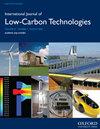通过选择所用工作流体的组成来提高太阳能集热器的效率
IF 2.3
4区 工程技术
Q3 ENERGY & FUELS
引用次数: 0
摘要
该研究的目的是确定当使用水与Fe3O4纳米颗粒和多壁碳纳米管的混合物作为工作流体时,真空管太阳能收集器的效率以及能量和火用分析。通过将工作流体中Fe3O4纳米颗粒的浓度从0.05至0.15重量%改变,发现在Fe3O4含量等于0.1重量%时实现了最大效率。在该浓度下,混合物中Fe3O4和多壁碳纳米管的比例在4:1到1:4之间变化。研究发现,Fe3O4/多壁碳纳米管的比例(1:4)可以将太阳能收集器的效率提高到84%。进行的火用分析表明,在没有添加纳米颗粒Fe3O4和多壁碳纳米管的情况下,并且以1∶4的比例添加纳米颗粒Fe3O4/多壁碳纳米管的水的火用破坏和熵产生的最小值来表征。本文章由计算机程序翻译,如有差异,请以英文原文为准。
Improving a solar collector’s efficiency by selecting the composition of the working fluid used
The study’s purpose was to determine the efficiency, as well as the energy and exergy analysis of the vacuum tube solar collector when using a mixture of water with Fe3O4 nanoparticles and multiwall carbon nanotubes in the selected percentage ratio as the working fluid. By varying the concentration of Fe3O4 nanoparticles in the working fluid from 0.05 to 0.15 wt. %, it was found that the maximum efficiency is achieved at a Fe3O4 content equal to 0.1 wt. %. At this concentration, the ratio of Fe3O4 and multiwall carbon nanotubes in the mixture varied from 4:1 to 1:4. It was found that the Fe3O4/ multiwall carbon nanotubes ratio (1:4) can increase the efficiency of the solar collector up to 84%. Exergy analysis performed showed that water without the addition of nanoparticles Fe3O4 and multiwall carbon nanotubes was characterized by the maximum values of exergy destruction and entropy generation at any level of solar radiation, and water with the addition of nanoparticles Fe3O4/ multiwall carbon nanotubes in a ratio of 1:4 was characterized by the minimum values of exergy destruction and entropy generation.
求助全文
通过发布文献求助,成功后即可免费获取论文全文。
去求助
来源期刊

International Journal of Low-carbon Technologies
Engineering-Architecture
CiteScore
4.30
自引率
4.30%
发文量
106
审稿时长
27 weeks
期刊介绍:
The International Journal of Low-Carbon Technologies is a quarterly publication concerned with the challenge of climate change and its effects on the built environment and sustainability. The Journal publishes original, quality research papers on issues of climate change, sustainable development and the built environment related to architecture, building services engineering, civil engineering, building engineering, urban design and other disciplines. It features in-depth articles, technical notes, review papers, book reviews and special issues devoted to international conferences. The journal encourages submissions related to interdisciplinary research in the built environment. The journal is available in paper and electronic formats. All articles are peer-reviewed by leading experts in the field.
 求助内容:
求助内容: 应助结果提醒方式:
应助结果提醒方式:


